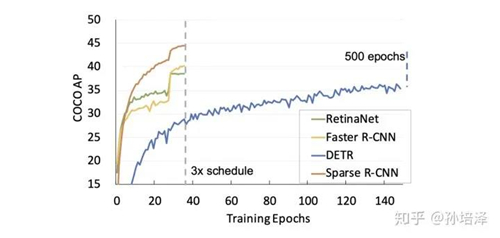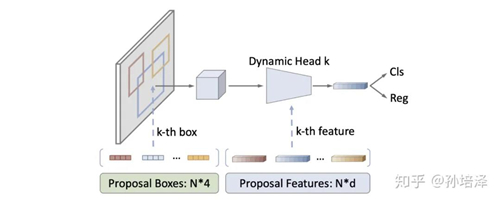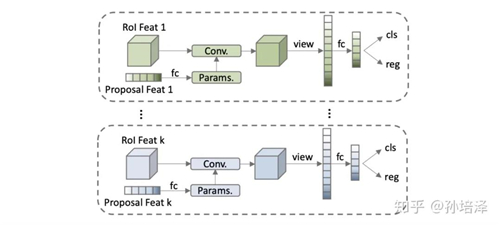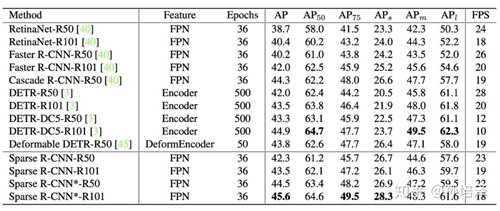全新的目標檢測范式Sparse R-CNN。
本文主要介紹一下我們最近的一篇工作:

沿著目標檢測領域中 Dense 和 Dense-to-Sparse 的框架,Sparse R-CNN 建立了一種徹底的 Sparse 框架, 脫離 anchor box,reference point,Region Proposal Network(RPN) 等概念,無需 Non-Maximum Suppression(NMS) 后處理, 在標準的 COCO benchmark 上使用 ResNet-50 FPN 單模型在標準 3x training schedule 達到了 44.5 AP 和 22 FPS。
Paper: https://arxiv.org/abs/2011.12450
Code: https://github.com/PeizeSun/SparseR-CNN
1. Motivation
我們先簡單回顧一下目標檢測領域中主流的兩大類方法。
第一大類是從非 Deep 時代就被廣泛應用的 dense detector,例如 DPM,YOLO,RetinaNet,FCOS。在 dense detector 中, 大量的 object candidates 例如 sliding-windows,anchor-boxes, reference-points 等被提前預設在圖像網格或者特征圖網格上,然后直接預測這些 candidates 到 gt 的 scaling/offest 和物體類別。
第二大類是 dense-to-sparse detector,例如,R-CNN 家族。這類方法的特點是對一組 sparse 的 candidates 預測回歸和分類,而這組 sparse 的 candidates 來自于 dense detector。
這兩類框架推動了整個領域的學術研究和工業應用。目標檢測領域看似已經飽和,然而 dense 屬性的一些固有局限總讓人難以滿意:
NMS 后處理
many-to-one 正負樣本分配
prior candidates 的設計
所以,一個很自然的思考方向就是:能不能設計一種徹底的 sparse 框架?最近,DETR 給出了一種 sparse 的設計方案。candidates 是一組 sparse 的 learnable object queries,正負樣本分配是 one-to-one 的 optimal bipartite matching,無需 nms 直接輸出最終的檢測結果。然而,DETR 中每個 object query 都和全局的特征圖做 attention 交互,這本質上也是 dense。而我們認為,sparse 的檢測框架應該體現在兩個方面:sparse candidates 和 sparse feature interaction。基于此,我們提出了 Sparse R-CNN。
Sparse R-CNN 拋棄了 anchor boxes 或者 reference point 等 dense 概念,直接從 a sparse set of learnable proposals 出發,沒有 NMS 后處理,整個網絡異常干凈和簡潔,可以看做是一個全新的檢測范式。

2.Sparse R-CNN
Sparse R-CNN 的 object candidates 是一組可學習的參數,N*4,N 代表 object candidates 的個數,一般為 100~300,4 代表物體框的四個邊界。這組參數和整個網絡中的其他參數一起被訓練優化。That's it,完全沒有 dense detector 中成千上萬的枚舉。這組 sparse 的 object candidates 作為 proposal boxes 用以提取 Region of Interest(RoI),預測回歸和分類。

這組學習到的 proposal boxes 可以理解為圖像中可能出現物體的位置的統計值,這樣 coarse 的表征提取出來的 RoI feature 顯然不足以精確定位和分類物體。于是,我們引入一種特征層面的 candidates,proposal features,這也是一組可學習的參數,N*d,N 代表 object candidates 的個數,與 proposal boxes 一一對應,d 代表 feature 的維度,一般為 256。這組 proposal features 與 proposal boxes 提取出來的 RoI feature 做一對一的交互,從而使得 RoI feature 的特征更有利于定位和分類物體。相比于原始的 2-fc Head,我們的設計稱為 Dynamic Instance Interactive Head。

Sparse R-CNN 的兩個顯著特點就是 sparse object candidates 和 sparse feature interaction,既沒有 dense 的成千上萬的 candidates,也沒有 dense 的 global feature interaction。Sparse R-CNN 可以看作是目標檢測框架從 dense 到 dense-to-sparse 到 sparse 的一個方向拓展。
3. Architecture Design
Sparse R-CNN 的網絡設計原型是 R-CNN 家族。
Backbone 是基于 ResNet 的 FPN。
Head 是一組 iterative 的 Dynamic Instance Interactive Head,上一個 head 的 output features 和 output boxes 作為下一個 head 的 proposal features 和 proposal boxes。Proposal features 在與 RoI features 交互之前做 self-attention。
訓練的損失函數是基于 optimal bipartite matching 的 set prediction loss。

從 Faster R-CNN(40.2 AP) 出發,直接將 RPN 替換為 a sparse set of learnable proposal boxes,AP 降到 18.5;引入 iterative 結構提升 AP 到 32.2;引入 dynamic instance interaction 最終提升到 42.3 AP。
4. Performance
我們沿用了 Detectron2 的 3x training schedule,因此將 Sparse R-CNN 和 Detectorn2 中的 detectors 做比較(很多方法沒有報道 3x 的性能,所以沒有列出)。同時,我們也列出了同樣不需要 NMS 后處理的 DETR 和 Deformable DETR 的性能。Sparse R-CNN 在檢測精度,推理時間和訓練收斂速度都展現了相當有競爭力的性能。

5. Conclusion
R-CNN 和 Fast R-CNN 出現后的一段時期內,目標檢測領域的一個重要研究方向是提出更高效的 region proposal generator。Faster R-CNN 和 RPN 作為其中的佼佼者展現出廣泛而持續的影響力。Sparse R-CNN 首次展示了簡單的一組可學習的參數作為 proposal boxes 即可達到 comparable 的性能。我們希望我們的工作能夠帶給大家一些關于 end-to-end object detection 的啟發。

